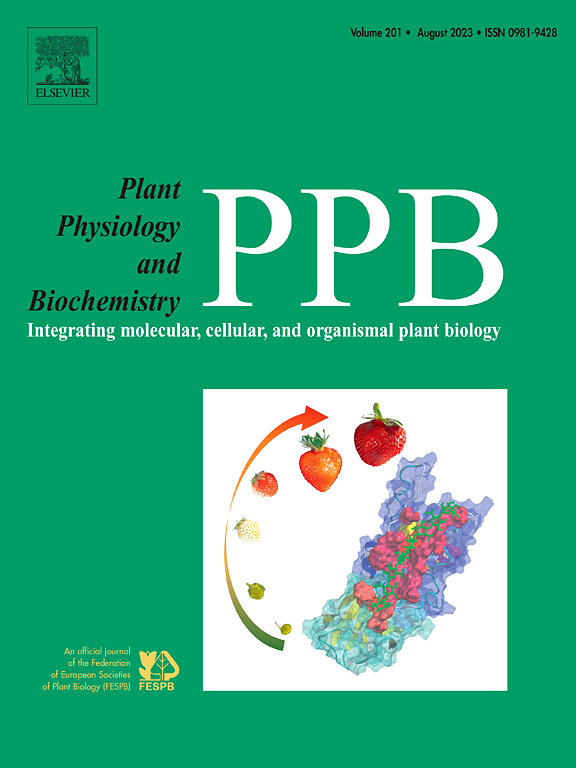细胞内Mn迁移和对H2O2积累的差异反应解释了荔枝品种对黑果皮病的易感性
IF 6.1
2区 生物学
Q1 PLANT SCIENCES
引用次数: 0
摘要
荔枝黑果皮病(DPD)是荔枝果皮中锰含量过高引起的一种生理疾病,影响果实外观和市场销售,造成巨大的经济损失。荔枝品种对DPD的易感性差异很大,但潜在的机制尚不清楚。本研究以同一果园为材料,研究了2个抗DPD品种(肥子小和黑叶)和1个敏感品种(桂薇)果实发育过程中果皮生理生化过程的差异。通过果实生长,贵味果皮锰含量显著低于肥子小,略高于黑叶。在Mn胁迫下,肥子霄和黑叶维持了ROS的稳态,而桂薇则积累了大量的H2O2。与肥子消和黑叶相比,患病桂薇花青素和可溶性糖减少,木质素增加。在桂薇中,Mn转运蛋白、光收集天线复合体、ROS清除蛋白和花青素合成相关酶的基因表达下调,而H2O2生成和木质素合成相关基因表达上调,葡萄糖代谢相关基因表达改变,表明锰在桂薇果皮细胞内运输和固存不良,过量的锰促进了H2O2的过量产生。抑制花青素合成、增强木质素积累和调节糖代谢使桂薇对锰胁迫具有适应性。综上所述,细胞内Mn转移能力差,以及过量Mn干扰下光合能量传递对H2O2积累的响应变化,是荔枝品种依赖性DPD脆弱性的共同原因。本文章由计算机程序翻译,如有差异,请以英文原文为准。
Intracellular Mn mobility and differential response to H2O2 accumulation explain the susceptibility of litchi cultivars to dark pericarp disease
Dark pericarp disease (DPD) in litchi is a physiological disease caused by excess manganese (Mn) in pericarp, impacting fruit appearance and marketability and leading to substantial economic loss. The susceptibility of litchi varieties to DPD differs greatly, but the underlying mechanisms remain vague. In this study, we investigated the discrepancies in physiological and biochemical processes in pericarp of two varieties (Feizixiao and Heiye) resistant to DPD and a susceptible cultivar (Guiwei) during fruit development from the same orchard. Pericarp Mn in Guiwei was significantly lower than that in Feizixiao and slightly higher than that in Heiye through fruit growth. Under Mn stress, Feizixiao and Heiye maintained ROS homeostasis, whereas substantial H2O2 accumulated in Guiwei. Reduced anthocyanins and soluble sugars and increased lignin were observed in diseased Guiwei compared to Feizixiao and Heiye. The expression of genes encoding Mn transporters, light-harvesting antenna complex, ROS scavenging proteins and enzymes involved in anthocyanin synthesis was downregulated, whereas that of genes functioning in H2O2 production and lignin synthesis was upregulated in Guiwei, and that of genes involved in glucose metabolism was altered, suggesting that Mn was poorly transported and sequestrated within Guiwei pericarp cells, and excess Mn boosted H2O2 overproduction. The inhibited anthocyanin synthesis, enhanced lignin accumulation and tuned sugar metabolism conferred Guiwei adaptability to Mn stress. Conclusively, the poor Mn intracellular transferability and variations in response to H2O2 accumulation associated with disturbed photosynthetic energy deliver under excess Mn, are collaboratively responsible for the cultivar-dependent DPD vulnerability in litchi.
求助全文
通过发布文献求助,成功后即可免费获取论文全文。
去求助
来源期刊
CiteScore
11.10
自引率
3.10%
发文量
410
审稿时长
33 days
期刊介绍:
Plant Physiology and Biochemistry publishes original theoretical, experimental and technical contributions in the various fields of plant physiology (biochemistry, physiology, structure, genetics, plant-microbe interactions, etc.) at diverse levels of integration (molecular, subcellular, cellular, organ, whole plant, environmental). Opinions expressed in the journal are the sole responsibility of the authors and publication does not imply the editors'' agreement.
Manuscripts describing molecular-genetic and/or gene expression data that are not integrated with biochemical analysis and/or actual measurements of plant physiological processes are not suitable for PPB. Also "Omics" studies (transcriptomics, proteomics, metabolomics, etc.) reporting descriptive analysis without an element of functional validation assays, will not be considered. Similarly, applied agronomic or phytochemical studies that generate no new, fundamental insights in plant physiological and/or biochemical processes are not suitable for publication in PPB.
Plant Physiology and Biochemistry publishes several types of articles: Reviews, Papers and Short Papers. Articles for Reviews are either invited by the editor or proposed by the authors for the editor''s prior agreement. Reviews should not exceed 40 typewritten pages and Short Papers no more than approximately 8 typewritten pages. The fundamental character of Plant Physiology and Biochemistry remains that of a journal for original results.

 求助内容:
求助内容: 应助结果提醒方式:
应助结果提醒方式:


